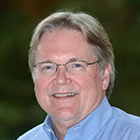Plenary Speakers
Tuesday, April 24, 2018
8:30am – 10:00am
Coastal Environmental Settings as a Model to Explain Global Controls of Carbon Storage in Mangroves

Robert Twilley, Ph.D.
Executive Director, Louisiana Sea Grant College Program;
Professor, Oceanography and Coastal Sciences, Baton Rouge, LA
Mangrove forests are found in dynamic coastal landforms controlled by physical forcings (e.g. river, tides and waves) and geomorphic evolutionary processes (e.g. rate and source of sediment input, and rate of relative sea-level change). Combined, these processes create a range of clastic coastal environments spanning from prograding to transgressive embayed shorelines. Dr. Twilley’s presentation will discuss how the environmental drivers - wave power, tidal and fluvial processes - along with regional climate, produce conspicuous coastal environmental settings, including deltas, estuaries, lagoons and karstic landforms. Built on the ecogeomorphogy framework, the coastal environmental setting approach recognizes hydrology, geomorphology, and climate as main components to macrosystem-scale variation in coastal wetland’s ecological processes. Hence, each coastal setting has a conspicuous environmental signature that controls both the type and rate of sediment supply to the coastline, nutrient load and limitation (e.g. nitrogen-to-phosphorus stoichiometric ratio), organic matter diagenesis, and, ultimately, C storage in vegetation (above- and belowground biomass) and soil pools. This presentation will further discuss how considering nitrogen (N) and phosphorus (P) density in soils may represent conditions limiting macrosystem-scale C stocks, C-N-P stoichiometric interactions may enhance or weaken the carbon-climate feedback. Thus, reconciling site-specific mechanisms regulating C:N:P stoichiometry with macrosystem-scale processes in mangrove ecosystems is key to advance conceptual models that can improve our capacity to predict global C stocks and rates of sequestration in these and other coastal wetlands.
Wednesday, April 25, 2018
8:30am – 10:00am
Carbon Remineralization and Burial in the Coastal Margin: Linkages in the Anthropocene

Thomas S. Bianchi, Ph.D.
Jon and Beverly Thompson Endowed Chair of Geological Sciences, Department of Geological Sciences, University of Florida, Gainesville, FL
Continental margin systems collectively receive and store vast amounts of organic carbon (OC) derived from primary productivity both on land and in the ocean, thereby playing a central role in the global carbon cycle. The land-ocean interface is however extremely heterogeneous in terms of terrigenous inputs, marine primary productivity, sediment transport processes and, depositional conditions such as bottom water oxygen levels. Continental margins are also highly dynamic, with processes occurring over a broad range of spatial and temporal scales. The rates of organic carbon burial and oxidation are consequently variable over both space and time, hindering our ability to derive a global picture of OC cycling at the land-ocean interface. In this presentation, Dr. Bianchi will review the processes controlling the fate of organic matter in continental margin sediments with a special emphasis on “hot spots” and “hot moments” of OC burial and oxidation. In addition, he will present a compilation of compositional data from a set of illustrative settings, including fjords, small mountainous river margins, large deltaic systems and upwelling areas.

